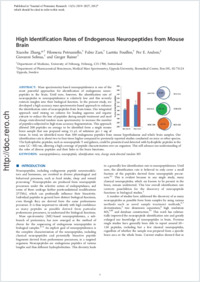High identification rates of endogenous neuropeptides from mouse brain
- Zhang, Xiaozhe Department of Medicine, University of Fribourg, Fribourg, CH-1700, Switzerland
- Petruzziello, Filomena Department of Medicine, University of Fribourg, Fribourg, CH-1700, Switzerland
- Zani, Fabio Department of Medicine, University of Fribourg, Fribourg, CH-1700, Switzerland
- Fouillen, Laetitia Department of Medicine, University of Fribourg, Fribourg, CH-1700, Switzerland
- Andren, Per E. Department of Pharmaceutical Biosciences, Medical Mass Spectrometry, Uppsala University, Biomedical Centre, Box 591, SE-75124 Uppsala, Sweden
- Solinas, Giovanni Department of Medicine, University of Fribourg, Fribourg, CH-1700, Switzerland
- Rainer, Gregor Department of Medicine, University of Fribourg, Fribourg, CH-1700, Switzerland
-
19.03.2012
Published in:
- Journal of Proteome Research. - 2012, vol. 11, no. 5, p. 2819–2827
English
Mass spectrometry-based neuropeptidomics is one of the most powerful approaches for identification of endogenous neuropeptides in the brain. Until now, however, the identification rate of neuropeptides in neuropeptidomics is relatively low and this severely restricts insights into their biological function. In the present study, we developed a high accuracy mass spectrometry-based approach to enhance the identification rates of neuropeptides from brain tissue. Our integrated approach used mixing on column for loading aqueous and organic extracts to reduce the loss of peptides during sample treatment and used charge state-directed tandem mass spectrometry to increase the number of peptides subjected to high mass accuracy fragmentation. This approach allowed 206 peptides on average to be identified from a single mouse brain sample that was prepared using 15 μL of solutions per 1 mg of tissue. In total, we identified more than 500 endogenous peptides from mouse hypothalamus and whole brain samples. Our identification rate is about two to four times higher compared to previously reported studies conducted on mice or other species. The hydrophobic peptides, such as neuropeptide Y and galanin, could be presented and detected with hydrophilic peptides in the same LC–MS run, allowing a high coverage of peptide characterization over an organism. This will advance our understanding of the roles of diverse peptides and their links in the brain functions.
- Faculty
- Faculté des sciences et de médecine
- Department
- Département de Médecine
- Language
-
- English
- Classification
- Biological sciences
- License
- License undefined
- Identifiers
-
- RERO DOC 29579
- DOI 10.1021/pr3001699
- Persistent URL
- https://folia.unifr.ch/unifr/documents/302439
Other files
Statistics
Document views: 81
File downloads:
- rai_hir.pdf: 227
- rai_hir_sm.pdf: 136

